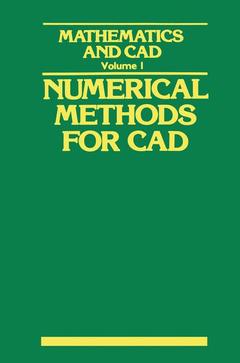Mathematics and CAD, Softcover reprint of the original 1st ed. 1985 Volume 1: Numerical Methods for CAD
Langue : Anglais
Auteur : Gardan Y.

The use of computer-aided design (CAD) systems always involves the introduction of mathematical concepts. It is important, therefore, for any systems designer to have a good grasp of the mathematical bases used in CAD. The choice of mathematical models in a system also has an effect on the overall quality, although this effect may not always be visible to the final user. Depending on whether Bezier or B-spline functions are used for curves and surfaces, for example, the final user even if not a com puter scientist will notice a difference. If, for example, one of the control points is modified by the user, in a Bezier-type representation, the curve or surface will tend to be modified overall, but in a B-spline representation, the curve or surface will tend to be modified close to the point, and there only. More possibly harmful, however, is the effect of the mathematical model which has a number of properties invisible and unknown to the final user. In every case a model must be chosen with, it is hoped, the most appropriate characteristics and limits for the task in hand.
1 Basic problems using graphics.- Matrices.- Homogeneous coordinates.- Two-dimensional calculations.- Basic calculations.- Construction under constraint.- Calculation of perimeters and areas.- Two-dimensional geometric transformations.- Basic transformations.- Concatenation of transformations.- Three-dimensional geometric transformations.- Basic transformations.- Concatenation of transformations.- Parallel projections and perspectives.- Axonometric projections.- Oblique projections.- Perspective projections.- Object modelling.- Conclusions.- References.- 2 Curves and surfaces.- Interpolation.- Smoothing.- Approximation.- Linearity.- Choice of a base.- Data structure.- Curves.- Interpolation.- Smoothing.- Approximation.- Comments.- Curves in a plane and in space.- Surfaces.- Tensor product.- Methods for use with irregularly spaced points.- Automatic triangulation.- References.- 3 Numerical methods for solving linear and non-linear equations.- Linear equation systems.- Direct methods.- Iterative methods.- Non-linear equation systems.- General introduction.- Newton’s method.- If the Jacobian is not known.- Link with optimization problems in Rn.- Mathematical tools for analysing convergence.- Non-linear equations.- General cases.- Specific examples with polynomial equations.- Calculation of specific values of a square matrix.- Conclusions.- Gauss method with pivot.- Relaxation method.- Newton’s method.- References.- Software manuals.- 4 The finite element method.- Examples of variational formulation for boundary value problems.- Example 1: homogeneous Dirichlet problem.- Example 2: homogeneous Neumann problem.- Example 3: non-homogeneous Neumann problem.- Internal approximation: Ritz-Galerkin method.- Matching finite elements.- Examples of finite elements.- Finite triangular elements P1 or type (1).- Finite rectangular elements Q1,.- Finite triangular elements P2 or type (2).- Finite rectangular elements Q2.- Families defined from a reference element.- Hermite triangle.- Argyris triangle.- A two-dimensional example.- Conclusions.- Appendix: the principle behind the finite difference method.- References.
Date de parution : 02-2012
Ouvrage de 166 p.
15.5x23.5 cm
Disponible chez l'éditeur (délai d'approvisionnement : 15 jours).
Prix indicatif 52,74 €
Ajouter au panier
© 2024 LAVOISIER S.A.S.



